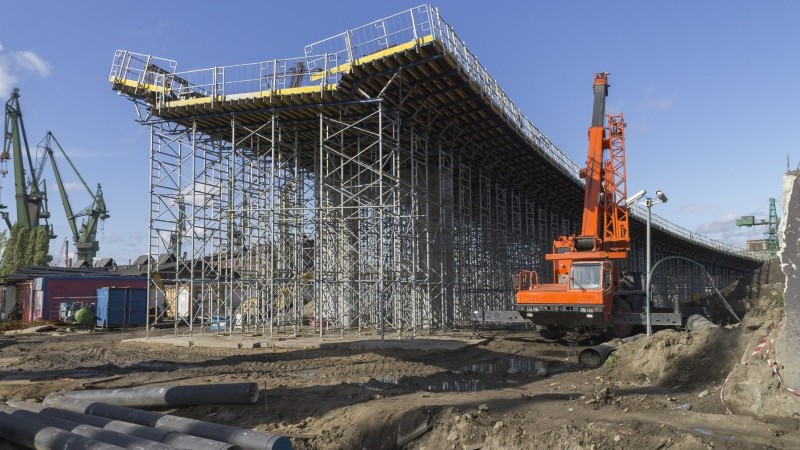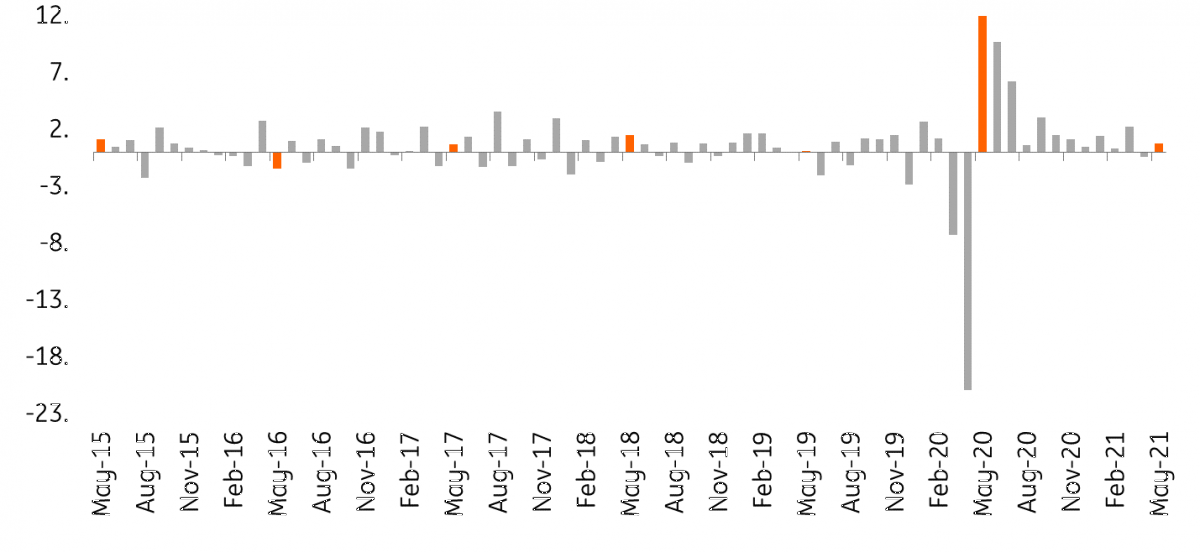Thanks to the re-opening of the economy, production in Poland saw strong growth in May in spite of the record supply chain disruptions generating increasing cost pressures. We expect average annual CPI to amount to 4.3% YoY in 2021 and 3.8% YoY in 2022.

Construction of a bridge in Gdansk, Poland
In May, Polish industrial production grew by 29.8% year-on-year, after the record +44.5% YoY growth in April.
The year-on-year output growth was mainly due to the low 2020 base, which is why seasonally adjusted month-on-month dynamics are a better indicator of the momentum in the economy.
The consensus was at 29.0%, and even the highest forecasts ca. 35% YoY.
Industrial production (%MoM, seasonally adjusted)

Source: CSO
On a seasonally adjusted MoM basis, manufacturing grew 0.8% compared to a 0.4% decline in April. This is a relatively good performance, although the rebound could have been stronger. The rebound from the re-opening of the economy in May was offset by record supply shortages in manufacturing companies, and the MoM data shows that the disruptions were most pronounced in car manufacturing (drop by 9.1%MoM).
Nonetheless, this is still good data and soft indicators e.g. PMI, growth in domestic orders, point to a strong rebound in the coming months.
Manufacturing: Shortage of equipment and raw materials act as a barrier

Source: CSO
In year-on-year terms, high growth rates against the lows seen in May 2020 are seen in the production of motor vehicles (+103.9% YoY), computers (+70.2% YoY), and furniture (+41.8% YoY). Export sectors continue to benefit from the worldwide shift in demand to durable goods supported by the global and domestic economic recovery in recent months.
CSO data shows a continued rebound in production of durable consumer goods (+49.4%YoY), capital goods (+51.3%YoY), and intermediate goods (+34.2%).
The re-opening effect and associated disturbances in the demand-supply balance have been followed by strong cost pressures in companies, which has led some to raise prices.
In May, Polish PPI inflation accelerated to 6.5% YoY from 5.5% YoY in April. Prices in manufacturing accelerated strongly to 6.3% YoY from 5.3% in April. The current cost-driven nature of inflation in Poland should soon have more demand-driven sources. In our opinion, we should see a stronger rebound in consumption in the second half of 2021. Demand pressures in 2022 are likely to be strengthened by the Keynesian effects of the Polish deal financed by the EU Recovery Fund.
We expect the average annual CPI to amount to 4.3% YoY in 2021 and 3.8% YoY in 2022.
Disclaimer: This publication has been prepared by the Economic and Financial Analysis Division of ING Bank N.V. (“ING”) solely for information purposes without regard to any ...
more
Disclaimer: This publication has been prepared by the Economic and Financial Analysis Division of ING Bank N.V. (“ING”) solely for information purposes without regard to any particular user's investment objectives, financial situation, or means. ING forms part of ING Group (being for this purpose ING Group NV and its subsidiary and affiliated companies). The information in the publication is not an investment recommendation and it is not investment, legal or tax advice or an offer or solicitation to purchase or sell any financial instrument. Reasonable care has been taken to ensure that this publication is not untrue or misleading when published, but ING does not represent that it is accurate or complete. ING does not accept any liability for any direct, indirect or consequential loss arising from any use of this publication. Unless otherwise stated, any views, forecasts, or estimates are solely those of the author(s), as of the date of the publication and are subject to change without notice.
The distribution of this publication may be restricted by law or regulation in different jurisdictions and persons into whose possession this publication comes should inform themselves about, and observe, such restrictions.
Copyright and database rights protection exists in this report and it may not be reproduced, distributed or published by any person for any purpose without the prior express consent of ING. All rights are reserved. ING Bank N.V. is authorised by the Dutch Central Bank and supervised by the European Central Bank (ECB), the Dutch Central Bank (DNB) and the Dutch Authority for the Financial Markets (AFM). ING Bank N.V. is incorporated in the Netherlands (Trade Register no. 33031431 Amsterdam). In the United Kingdom this information is approved and/or communicated by ING Bank N.V., London Branch. ING Bank N.V., London Branch is deemed authorised by the Prudential Regulation Authority and is subject to regulation by the Financial Conduct Authority and limited regulation by the Prudential Regulation Authority. The nature and extent of consumer protections may differ from those for firms based in the UK. Details of the Temporary Permissions Regime, which allows EEA-based firms to operate in the UK for a limited period while seeking full authorisation, are available on the Financial Conduct Authority’s website.. ING Bank N.V., London branch is registered in England (Registration number BR000341) at 8-10 Moorgate, London EC2 6DA. For US Investors: Any person wishing to discuss this report or effect transactions in any security discussed herein should contact ING Financial Markets LLC, which is a member of the NYSE, FINRA and SIPC and part of ING, and which has accepted responsibility for the distribution of this report in the United States under applicable requirements.
less
How did you like this article? Let us know so we can better customize your reading experience.






